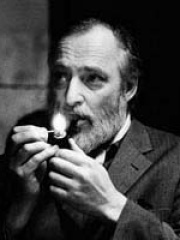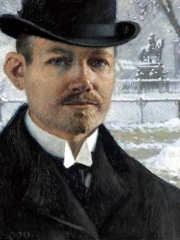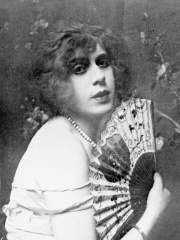
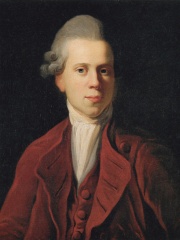
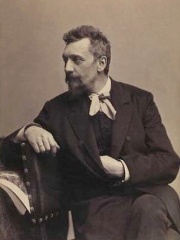
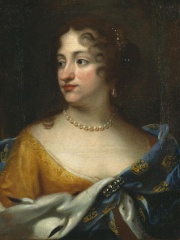
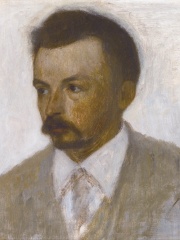
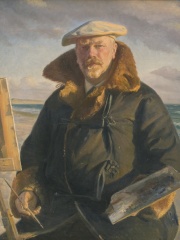
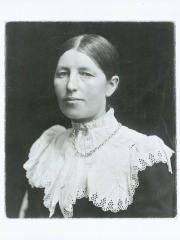
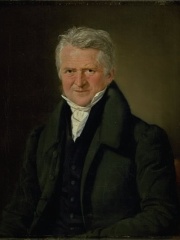
The Most Famous
PAINTERS from Denmark
This page contains a list of the greatest Danish Painters. The pantheon dataset contains 2,023 Painters, 33 of which were born in Denmark. This makes Denmark the birth place of the 14th most number of Painters behind Switzerland, and Austria.
Top 10
The following people are considered by Pantheon to be the top 10 most legendary Danish Painters of all time. This list of famous Danish Painters is sorted by HPI (Historical Popularity Index), a metric that aggregates information on a biography's online popularity. Visit the rankings page to view the entire list of Danish Painters.

1. Lili Elbe (1882 - 1931)
With an HPI of 74.30, Lili Elbe is the most famous Danish Painter. Her biography has been translated into 47 different languages on wikipedia.
Lili Ilse Elvenes (28 December 1882 – 13 September 1931), better known as Lili Elbe, was a Danish painter, transgender woman, and one of the earliest recipients of gender-affirming surgery (then called sex reassignment surgery). Elbe was a painter under her birth name Einar Wegener. After transitioning in 1930, she changed her legal name to Lili Ilse Elvenes, stopped painting, and later adopted the surname Elbe. She was the first known recipient of a uterus transplant in an attempt to achieve pregnancy, but died due to the subsequent complications. The UK and US versions of her semi-autobiographical narrative were published posthumously in 1933 under the title Man into Woman: An Authentic Record of a Change of Sex. A film inspired by her life, The Danish Girl, was released in 2015. An opera based on her life, Lili Elbe, composed by Tobias Picker, premiered in 2023.

2. Nicolai Abildgaard (1743 - 1809)
With an HPI of 73.53, Nicolai Abildgaard is the 2nd most famous Danish Painter. His biography has been translated into 40 different languages.
Nicolai Abraham Abildgaard (11 September 1743 – 4 June 1809) was a Danish neoclassical and royal history painter, sculptor, architect, and professor of painting, mythology, and anatomy at the New Royal Danish Academy of Art in Copenhagen, Denmark. Many of his works were in the royal Christiansborg Palace (some destroyed by fire 1794), Fredensborg Palace, and Levetzau Palace at Amalienborg.

3. Carl Bloch (1834 - 1890)
With an HPI of 71.53, Carl Bloch is the 3rd most famous Danish Painter. His biography has been translated into 28 different languages.
Carl Heinrich Bloch (Danish pronunciation: [ˈkʰɑːˀl ˈplɒk]; 23 May 1834 – 22 February 1890) was a Danish painter.

4. Ulrika Eleonora of Denmark (1656 - 1693)
With an HPI of 71.05, Ulrika Eleonora of Denmark is the 4th most famous Danish Painter. Her biography has been translated into 38 different languages.
Ulrika Eleonora of Denmark (11 September 1656 – 26 July 1693) was Queen of Sweden as the wife of King Charles XI. She is often admired for her generosity and charity. The name Ulrike is a Danish version of the name; in Swedish she is called Ulrika Eleonora den äldre (English: Ulrica Eleanor the Elder), to distinguish her from her daughter, the future queen regnant.
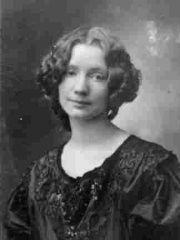
5. Gerda Wegener (1886 - 1940)
With an HPI of 70.31, Gerda Wegener is the 5th most famous Danish Painter. Her biography has been translated into 38 different languages.
Gerda Marie Fredrikke Wegener (née Gottlieb; 15 March 1885 – 28 July 1940) was a Danish illustrator and painter. Wegener is known for her fashion illustrations and later her paintings that pushed the boundaries of her time concerning gender and love. These works were classified as lesbian erotica at times and many were inspired by her partner, transgender painter Lili Elbe. Wegener employed these works in the styles of Art Nouveau and later Art Deco. Gerda Wegener also drew a few comics.

6. Vilhelm Hammershøi (1864 - 1916)
With an HPI of 70.30, Vilhelm Hammershøi is the 6th most famous Danish Painter. His biography has been translated into 30 different languages.
Vilhelm Hammershøi (), often anglicised as Vilhelm Hammershoi (15 May 1864 – 13 February 1916), was a Danish painter. He is known for his poetic, subdued portraits and interiors. In 1905, Rainer Maria Rilke wrote of the artist, "Hammershøi is not one of those about whom one can speak quickly. His work is wide-ranging and slow, and at whatever moment one comprehends it, it will always provide an opportunity to talk about what is important and essential in art".

7. Michael Ancher (1849 - 1927)
With an HPI of 68.45, Michael Ancher is the 7th most famous Danish Painter. His biography has been translated into 35 different languages.
Michael Peter Ancher (9 June 1849 – 19 September 1927) was a Danish realist artist, widely known for his paintings of fishermen, the Skagerak and the North Sea, and other scenes from the Danish fishing community in Skagen.

8. Anna Ancher (1859 - 1935)
With an HPI of 68.11, Anna Ancher is the 8th most famous Danish Painter. Her biography has been translated into 35 different languages.
Anna Ancher (18 August 1859 – 15 April 1935) was a Danish artist associated with the Skagen Painters, an artist colony on the northern point of Jylland, Denmark. She is considered to be one of Denmark's greatest visual artists.

9. Christoffer Wilhelm Eckersberg (1783 - 1853)
With an HPI of 66.88, Christoffer Wilhelm Eckersberg is the 9th most famous Danish Painter. His biography has been translated into 36 different languages.
Christoffer Wilhelm Eckersberg (2 January 1783 – 22 July 1853) was a Danish painter. He was born in Blåkrog in the Duchy of Schleswig (now in Aabenraa Municipality, in the southern part of Jutland in Denmark). He went on to lay the foundation for the period of art known as the Golden Age of Danish Painting, and is referred to as the "Father of Danish painting".
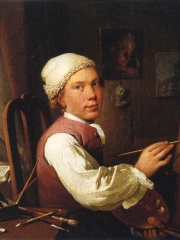
10. Jens Juel (1745 - 1802)
With an HPI of 65.06, Jens Juel is the 10th most famous Danish Painter. His biography has been translated into 27 different languages.
Jens Juel (12 May 1745 – 27 December 1802) was a Danish painter, primarily known for his many portraits, of which the largest collection is on display at Frederiksborg Castle. He is regarded as the leading Danish portrait painter of the 18th century.
People
Pantheon has 33 people classified as Danish painters born between 1656 and 1938. Of these 33, none of them are still alive today. The most famous deceased Danish painters include Lili Elbe, Nicolai Abildgaard, and Carl Bloch.
Deceased Danish Painters
Go to all RankingsLili Elbe
1882 - 1931
HPI: 74.30
Nicolai Abildgaard
1743 - 1809
HPI: 73.53
Carl Bloch
1834 - 1890
HPI: 71.53
Ulrika Eleonora of Denmark
1656 - 1693
HPI: 71.05
Gerda Wegener
1886 - 1940
HPI: 70.31
Vilhelm Hammershøi
1864 - 1916
HPI: 70.30
Michael Ancher
1849 - 1927
HPI: 68.45
Anna Ancher
1859 - 1935
HPI: 68.11
Christoffer Wilhelm Eckersberg
1783 - 1853
HPI: 66.88
Jens Juel
1745 - 1802
HPI: 65.06
Asger Jorn
1914 - 1973
HPI: 65.00
Paul Gustav Fischer
1860 - 1934
HPI: 63.81
Overlapping Lives
Which Painters were alive at the same time? This visualization shows the lifespans of the 25 most globally memorable Painters since 1700.

